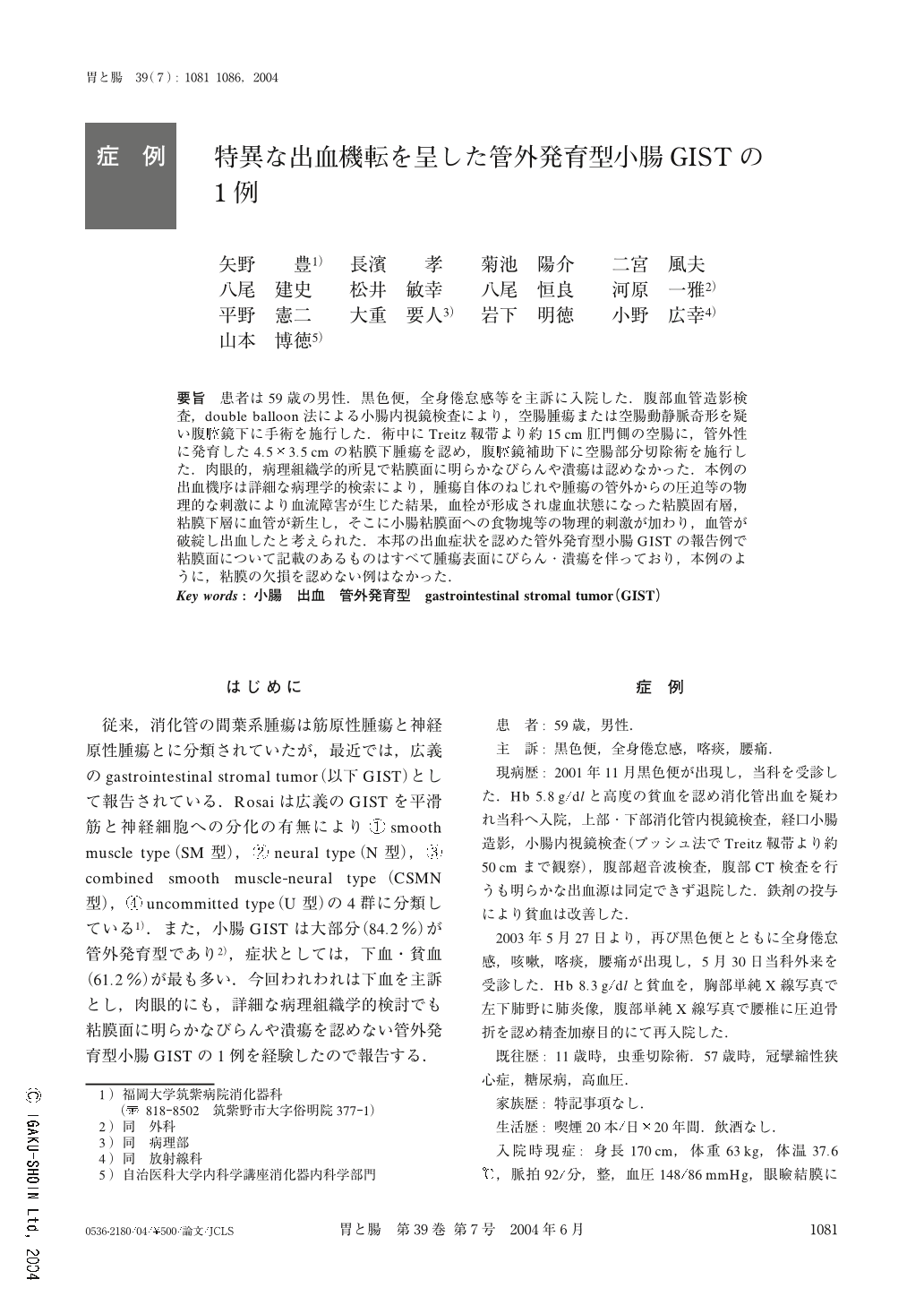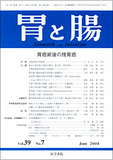Japanese
English
- 有料閲覧
- Abstract 文献概要
- 1ページ目 Look Inside
- 参考文献 Reference
- サイト内被引用 Cited by
要旨 患者は59歳の男性.黒色便,全身倦怠感等を主訴に入院した.腹部血管造影検査,double balloon法による小腸内視鏡検査により,空腸腫瘍または空腸動静脈奇形を疑い腹腔鏡下に手術を施行した.術中にTreitz靱帯より約15cm肛門側の空腸に,管外性に発育した4.5×3.5cmの粘膜下腫瘍を認め,腹腔鏡補助下に空腸部分切除術を施行した.肉眼的,病理組織学的所見で粘膜面に明らかなびらんや潰瘍は認めなかった.本例の出血機序は詳細な病理学的検索により,腫瘍自体のねじれや腫瘍の管外からの圧迫等の物理的な刺激により血流障害が生じた結果,血栓が形成され虚血状態になった粘膜固有層,粘膜下層に血管が新生し,そこに小腸粘膜面への食物塊等の物理的刺激が加わり,血管が破綻し出血したと考えられた.本邦の出血症状を認めた管外発育型小腸GISTの報告例で粘膜面について記載のあるものはすべて腫瘍表面にびらん・潰瘍を伴っており,本例のように,粘膜の欠損を認めない例はなかった.
A hemorrhagic GIST in the small intestine usually has erosions or ulcers on its surface. We describe a hemorrhagic jejunal GIST which manifested neither erosion nor ulcer on the surface. A 59-year-old man was admitted because of recurring tarry stool and severe anemia. Upper GI endoscopy, total colonoscopy, and small intestinal radiography showed no abnormal findings, while abdominal angiography demonstrated a hypervascular lesion in the early phase of arteriography for the second branch of the jejunal artery. We examined the patient by double-balloon enteroscopy. The enteroscopic findings showed a submucosal tumor (SMT) without any erosion or ulcer, but with minute vessel-like redness on the surface, which was located 15cm distal from Treitz's ligament. We diagnosed this SMT as the origin of the bleeding and performed a laparoscopy-assisted resection of the small intestine. The tumor showed extraluminal growth pattern, which was measured as 4.5×3.5cm. Neither macroscopic nor microscopic findings revealed ulceration, erosion or hemorrhagic necrosis. In accordance with the histological findings using immunostain together with hematoxylin-eosin stain, the SMT was diagnosed as GIST, smooth muscle type with low-grade malignancy. The section also showed thrombus within the submucosal vessels, which suggested that the chronic ischemia was caused by mechanical stimuli such as distortion of the tumor. Futhermore, many dilated vessels proliferated in the lamina propria as well as in the submucosa. This phenomenon was thought to be a sign of neovascularization and hemosiderin-laden macrophages were observed to be present in the lamina propria. Based on these pathological investigations, we suggested that the hemorrhage from the present lesion could have been due to the rupture of these proliferated vessels, caused by mechanical stimulation (such as bolus of food) to the mucosa. There is no previous case report concerning such an unusual mechanism producing hemorrhage from GIST.
1) Department of Gastroenterology, Fukuoka University Chikushi Hospital, Chikushino, Japan

Copyright © 2004, Igaku-Shoin Ltd. All rights reserved.


